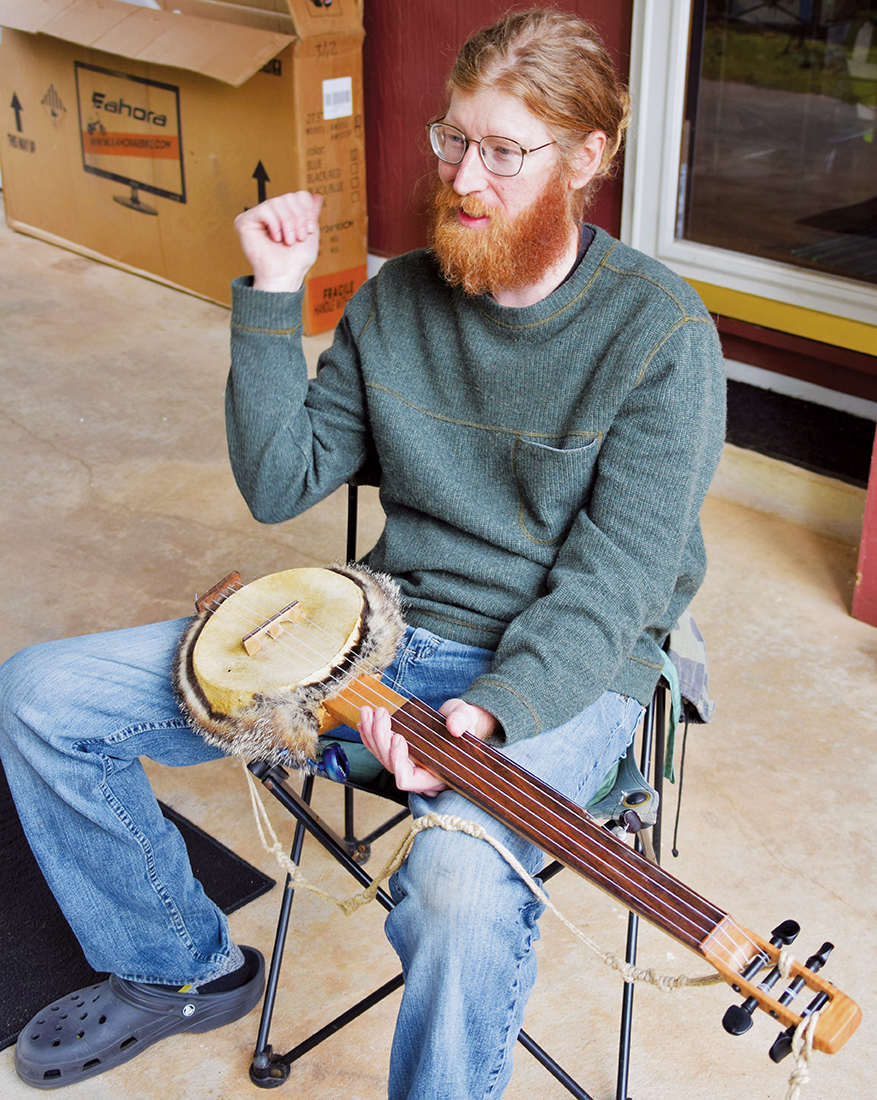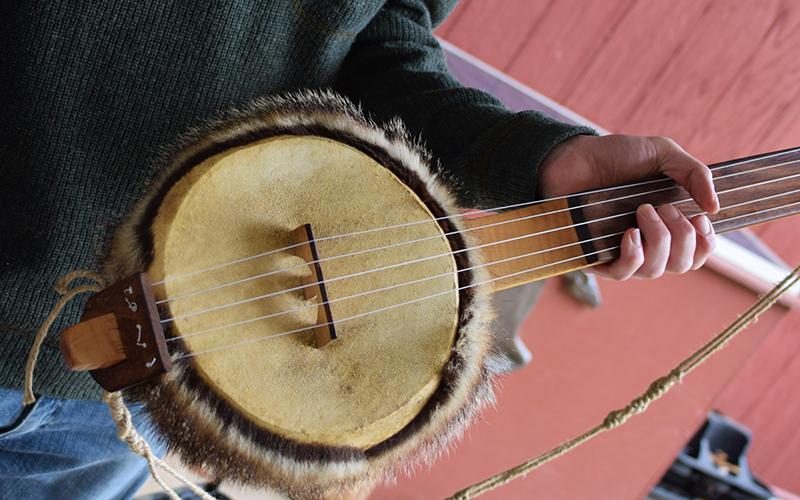Almond man crafts unique instruments
Almond – Even in 2020, a tangible connection to at least two centuries of Appalachian tradition can be found.
Nantahala native – and now Almond resident – Joshua Grant builds banjos similar to those played in the region between 1820-50.
The 39-year-old has built approximately 50 banjos over the past 11 years, starting in 2009. While Grant’s instruments are clearly banjos, several key differences exist between them, and the resonator and open-back instruments associated with bluegrass and old-time music, respectively. The instruments are fretless, and are built with gourd bodies and animal hide heads from groundhog, calf, deer or goat skin.
His banjos use high-end tonewoods, some of which are sourced from the region. The gourds he uses come from an organic family farm in California.
Grant’s personal banjo features a groundhog skin head from a groundhog killed by his dog, Runt. Groundhog fur still adorns the sides of the instrument.
“I don’t focus on production, I focus on the instrument I’m building at the time,” Grant said.
Grant explained that he built his first instrument because he could not afford the banjo he wanted when he was starting to play. He learned instrument building techniques as he constructed that first banjo.
“My goal right now is to attend the festivals where the goal is not to increase production, but to meet people who would want to pay what it’s worth,” Grant said. “Right now, I’m trying to nickel and dime myself to death, and I can’t do that. If my focus is on production, maybe I could justify doing that, but my focus is on preservation, not just (the) presentation of not only this art, (but) the sound of it. How it’s made. How its done.”
Grant’s banjos start at $600, and go up in price depending on the cost of components and options decided by the customer. Grant has also begun crafting baritone ukuleles, which sell for $300.
He said he plans to keep his $600 base price to keep his instruments more accessible.
“A lot of people say I need to up my price, and other people say I need to expose myself to a different market like Highlands and Cashiers and things like that, but I purposely and stubbornly keep it there to make people who are on a budget the way I was and couldn’t afford a $1,000 instrument,” Grant said. “You can put together three payments of $200, which anybody who’s focused and determined can do, even a little kid.”

Grant has sold banjos at Merlefest in Wilkesboro, and other similar music and craft festivals throughout the region. His banjos have also been seen on the big screen, as he was commissioned to build an instrument as a prop for the Hulu TV Series “Underground.” The banjo can be seen during the show’s second season.
“I got a phone call from them,” Grant said. “They were filming in Savannah, and they wanted a banjo for props for the upcoming season. They wanted one made, and I knew that they would go to someone else if I didn’t do it as fast as possible, so I told them I could do it in five days. I worked my butt off. My hands were just falling apart by the end of those five days, but I got it done and I sent it in.”
Grant said the most difficult part of building a banjo was intonation, or setting up the banjo to sound in tune and figuring out relatively where the frets would be on a fretted instrument.
“I’ve not been more than a quarter inch off in all of them I’ve made, and like I said, it’s fretless,” Grant said, “You don’t really have to move it. You can just rotate your hand a little bit, and that’s the difference between being perfectly in tune or not.”
He emphasized the mix of African, European and Native American influences over time leading to the creation of the five-string banjo.”
“The native peoples helped us and showed us what to harvest and how it acted like in the New World,” Grant said. “Without their help, there would be no banjo. There would be no American Banjo and there would be no old-time music if it wasn’t for natives.”
He said although Joel Walker Sweeney – a white minstrel musician from Appomattox, Va. is sometimes credited as the first to put a fifth string on the banjo, history suggests he took credit for an idea already put in place by enslaved people nearby.
The fifth string starts further down the neck than the other four and is played rhythmically with the thumb, while chords and melodies are played on the other four strings.
“Everybody knows, because there’s documentation that he was right around (a) bunch of slaves, so there was a slave that added a fifth string somewhere on it and he just copied that,” Grant said.
He also spoke to a need to change the perception of mountain music and to preserve the region’s culture.
“I’ve always hated the hokey presentation of mountain music,” Grant said. “Just like the hokieness of the Gatlinburg shirtless, shoeless, toothless mountain person, ignorant, uneducated, some stereotypes, sadly are based in truth, but we need to shatter a lot of those stereotypes.”
Grant has given presentations, talks and performances at the Stecoah Valley Center and Western Carolina University’s Appalachian Heritage Museum, as well as at local schools and other venues.
“At (Swain) West Elementary School, there were like 250 kids that played my banjo and heard about the history of the banjo,” Grant said. “That’s 250 kids more than when I was a kid and didn’t hear about it. I think it’s finding the time, organizing the people who are interested that want to help and acting upon it.
“We’ve got to all throw in on this to help preserve this, because leaving it up to just one or two folks is an overwhelming task right now.”
More information on Grant and his instruments can be found at grantcustombanjos.com.

